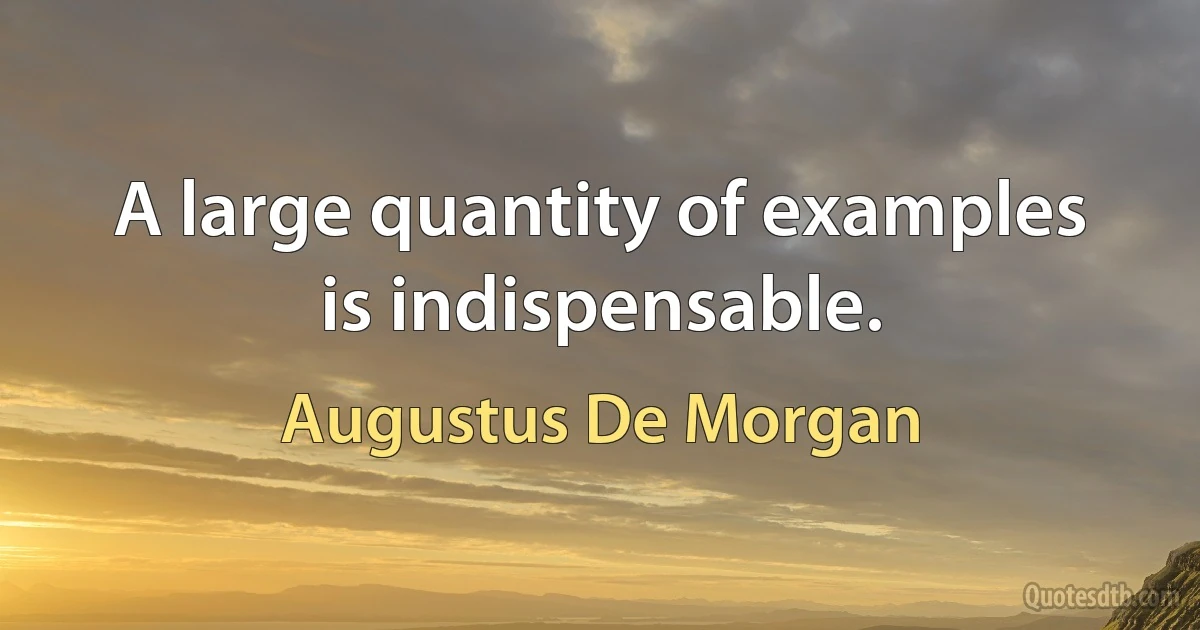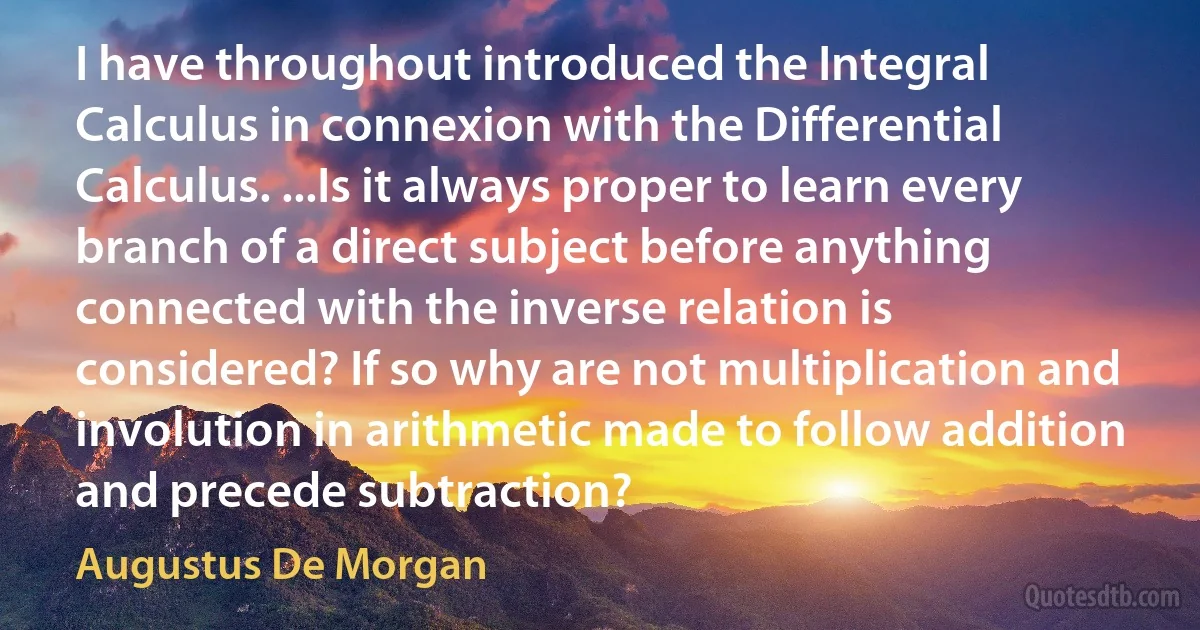Augustus De Morgan quotes - page 2
I... subjoin references to those parts of the work for which I have not been indebted to my knowledge of what has been written before me: much of what is cited is probably not new, indeed it is dangerous for any one at the present day to claim anything as belonging to himself; several things which I once thought to have entered in this list have been since found (either by myself, or by a friend to whom I referred it) in preceding writers.

Augustus De Morgan
It is not true, out of geometry, that the mathematical sciences are, in all their parts those models of finished accuracy which many suppose. The extreme boundaries of analysis have always been as imperfectly understood as the tract beyond the boundaries was absolutely unknown. But the way to enlarge the settled country has not been by keeping within it, but by making voyages of discovery, and I am perfectly convinced that the student should be exercised in this manner; that is, that he should be taught how to examine the boundary, as well as how to cultivate the interior. ...allowing all students whose capacity will let them read on the higher branches of applied mathematics, to have each his chance of being led to the cultivation of those parts of analysis on which rather depends its future progress than its present use in the sciences of matter.

Augustus De Morgan
When... we have a series of values of a quantity which continually diminish, and in such a way, that name any quantity we may, however small, all the values, after a certain value, are severally less than that quantity, then the symbol by which the values are denoted is said to diminish without limit. And if the series of values increase in succession, so that name any quantity we may, however great, all after a certain point will be greater, then the series is said to increase without limit. It is also frequently said, when a quantity diminishes without limit, that it has nothing, zero or 0, for its limit: and that when it increases without limit it has infinity or ∞ or 1⁄0 for its limit.

Augustus De Morgan
A great many individuals ever since the rise of the mathematical method, have, each for himself, attacked its direct and indirect consequences. ...I shall call each of these persons a paradoxer, and his system a paradox. I use the word in the old sense: ...something which is apart from general opinion, either in subject-matter, method, or conclusion. ...Thus in the sixteenth century many spoke of the earth's motion as the paradox of Copernicus, who held the ingenuity of that theory in very high esteem, and some, I think, who even inclined towards it. In the seventeenth century, the depravation of meaning took place... Phillips says paradox is "a thing which seemeth strange"-here is the old meaning...-"and absurd, and is contrary to common opinion," which is an addition due to his own time.

Augustus De Morgan
Spinoza's Philosophia Scripturæ Interpres, Exercitatio Paradoxa, printed anonymously ...is properly paradox, though also heterodox. It supposes, contrary to all opinion, orthodox and heterodox, that philosophy can... explain the Athanasian doctrine so as to be at least compatible with orthodoxy. The author would stand almost alone, if not quite; and this is what he meant.

Augustus De Morgan
Find a fraction which, multiplied by itself, shall give 6, or... find the square root of 6. This can be shown to be an impossible problem; for it can be shown that no fraction whatsoever multiplied by itself, can give a whole number, unless it be itself a whole number disguised in a fractional form, such as 4⁄2 or 21⁄3. To this problem, then, there is but one answer, that it is self-contradictory. But if we propose the following problem,-to find a fraction which, multiplied by itself, shall give a product lying between 6 and 6 + a; we find that this problem admits of solution in every case. It therefore admits of solution however small a may be... as small as you please.

Augustus De Morgan
When... we have a series of values of a quantity which continually diminish, and in such a way, that name any quantity we may, however small, all the values, after a certain value, are severally less than that quantity, then the symbol by which the values are denoted is said to diminish without limit. And if the series of values increase in succession, so that name any quantity we may, however great, all after a certain point will be greater, then the series is said to increase without limit.

Augustus De Morgan
The following is exactly what we mean by a LIMIT. ...let the several values of x... bea1 a2 a3 a4.... &c.;then if by passing from a1 to a2, from a2 to a3, &c.;, we continually approach to a certain quantity l [lower case L, for "limit"], so that each of the set differs from l by less than its predecessors; and if, in addition to this, the approach to l is of such a kind, that name any quantity we may, however small, namely z, we shall at last come to a series beginning, say with an, and continuing ad infinitum,an an+1 an+2.... &c.;all the terms of which severally differ from l by less than z: then l is called the limit of x with respect to the supposition in question.

Augustus De Morgan
Take a unit, halve it, halve the result, and so on continually. This gives-1 1⁄2 1⁄4 1⁄8 1⁄16 1⁄32 1⁄64 1⁄128 &c.;Add these together, beginning from the first, namely, add the first two, the first three, the first four, &c;... We see then a continual approach to 2, which is not reached, nor ever will be, for the deficit from 2 is always equal to the last term added.
...We say that-1, 1 + 1⁄2, 1 + 1⁄2 + 1⁄4, 1 + 1⁄2 + 1⁄4 + 1⁄8, &c.; &c.;is a series of quantities which continually approximate to the limit 2. Now the truth is, these several quantities are fixed, and do not approximate to 2. ...it is we ourselves who approximate to 2, by passing from one to another. Similarly when we say, "let x be a quantity which continually approximates to the limit 2," we mean, let us assign different values to x, each nearer to 2 than the preceding, and following such a law that we shall, by continuing our steps sufficiently far, actually find a value for x which shall be as near to 2 as we please.

Augustus De Morgan


